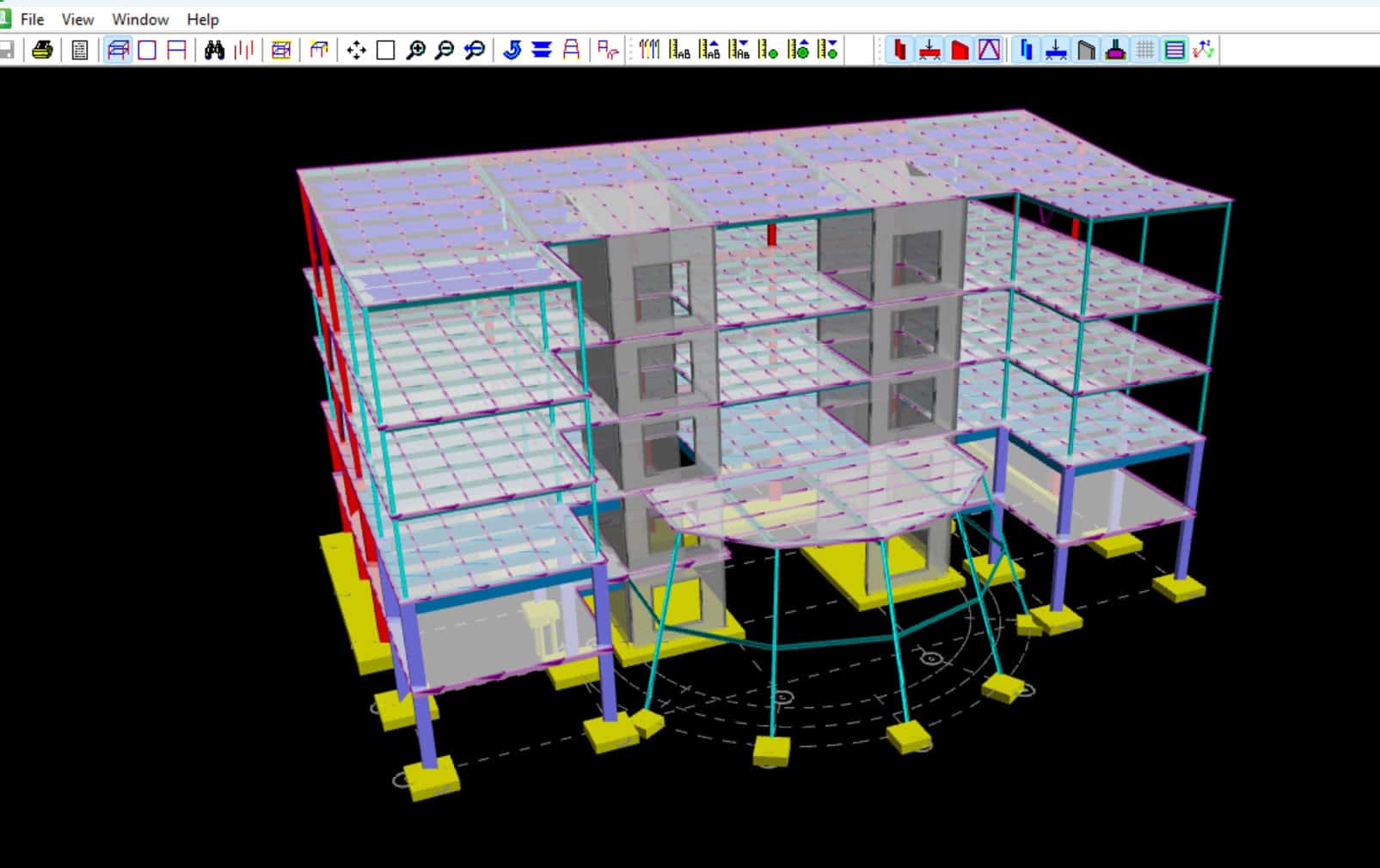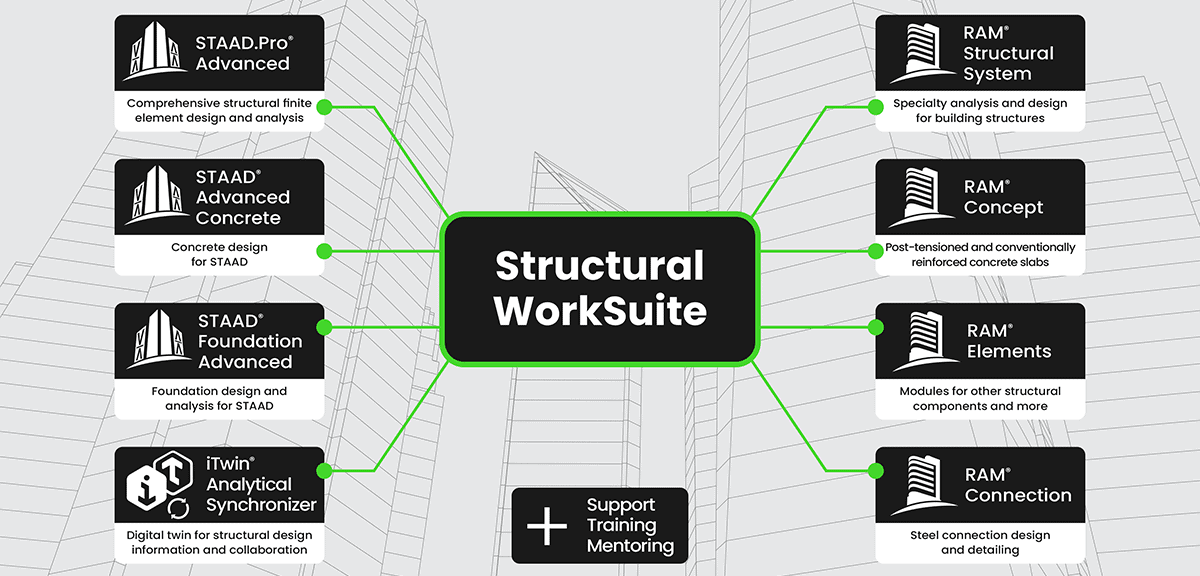As engineers in the architecture, engineering, and construction (AEC) sector, we have observed the widespread adoption of building information modeling (BIM). Over the past five years, the term “infrastructure digital twin” has taken center stage. What is the difference between BIM and an infrastructure digital twin? As structural engineers, we use software to create 3D models for analysis and design—so are we creating BIMs or infrastructure digital twins?
BIM is a static visualization capability employed during the design and construction phases of a building. BIM integrates all disciplines into a CAD-based model. The purpose of BIM is to enable collaboration between disciplines and visualize spatial constraints. BIM serves as foundational data used to create an infrastructure digital twin.
For example, your 3D structural analysis model can be exported and translated into a CAD format for use in BIM.
An infrastructure digital twin is a virtual representation of a real-world entity, synchronized at a specified frequency and fidelity. Real-time data from sensors and the Internet of Things (IoT) are linked to the accurate as-built digital model. The infrastructure digital twin serves as the smart building hub for owners and operators to schedule maintenance and ensure that the building is operating optimally.
Level of development
The International BIM Forum authors the Level of Development (LOD) specification. The LOD definitions provide a method to classify the level of detail and accuracy of information required in your digital model throughout the project’s lifecycle. We can align these levels with our project workflows and the software that we utilize.
LOD 100 and 200 take your model from mass models to more specific design. The design professional will use CAD-based applications to create these models.
In LOD 300, the BIM model is refined by adding accurate sizes and locations. The engineers will import their analysis models into the BIM model.
LOD 400 adds specific fabrication and installation information. Software that creates fabrication drawings is utilized in this step. The BIM model integrates with construction phasing software.
LOD 500 is the point when the BIM model is transitioned to an infrastructure digital twin. The model reflects the as-built condition, and the team uses asset management systems and digital models that read sensor data.
BIM toward the infrastructure digital twin
We are aware of the importance of BIM adoption around the world, considering that there are already very strong regulatory bodies. At the same time, there have been recent efforts in countries that include Chile, Colombia, Mexico, Brazil, and Argentina toward adoption.
BIM is a crucial part of the infrastructure digital twin. It takes the dimensions and levels of development of the BIM model to complete the rest of the audited information with an additional step of incorporating real-time sensors. A BIM file with a high level of development could have a robust model with lifecycle and operation included. On the other hand, the infrastructure digital twin incorporates audited information in real time, as it represents a complete virtual representation of all data, positive or not, and all relevant information, which almost completely replicates the multidiscipline system. It not only includes the model itself, but also external factors that include pressure measurements, earthquakes, winds, variable loads, and changes in the resistance of elements, as well as the impact of the environment in general.
Bentley’s structural portfolio
Bentley’s structural analysis software portfolio is comprised of STAAD.Pro, RAM Elements, RAM Structural System, RAM Concept, RAM Connection, STAAD.Foundation Advanced, and STAAD Advanced Concrete.
Each application has specific capabilities that correspond to analytical and physical modeling programs at the same time.
Physical modeling is responsible for BIM interoperability and includes STAAD, RAM Structural System, and RAM Elements.
Modeling or analytical interpretation is focused on the process of analysis and design:
- STAAD.Pro: Powerful structural analysis and design software that can model any type of structure with any material.
- RAM Structural System: Structural design software for buildings.
- RAM Elements: 3D structural analysis and design software for performing 3D finite element analysis of almost any type of structure or structural component.
Bentley BIM portfolio
Bentley’s BIM portfolio is diverse and covers all software that have BIM information associated with them, including:
ProStructures: Allows you to model structural systems, including fabrication elements, as well as the generation of drawings. It is subdivided into ProSteel and ProConcrete to direct attention towards steel or concrete structures.
OpenPlant: The main software for plant modeling. It works as an ideal link with ProStructures for multidiscipline projects of this type.
OpenBuildings: Building design software that enables BIM workflows for the design, analysis, simulation, and documentation of buildings.
Each software provides specialized solutions within the BIM environment, facilitating multidiscipline collaboration and efficient model creation for a wide range of projects in engineering and architecture.
For more information on topics related to BIM interoperability, check out our on-demand webinar.
Our new webinar that focuses on BIM fundamentals applied to calculation capabilities, as well as the interoperability of models between our main analytical capabilities and BIM programs, is available here!
For further exploration of topics related to structural BIM and iTwin Analytical Synchronizer, we invite you to review our documentation and links:
- iTwin Analytical Synchronizer ISM Import and Export
- iTwin Analytical Synchronizer by Bentley ServiceNow
For more information, please contact me at [email protected]








